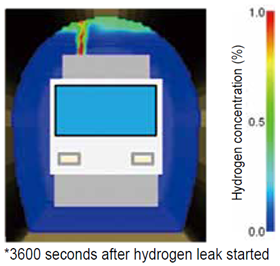23. Safety Assessment of Hydrogen Fuel Cell Multiple Units
For the social implementation of hydrogen fuel cell multiple units, it is necessary to establish technical regulatory standards in regulations and ordinances that allow the installation of hydrogen fuel as high-pressure gas on board without requiring special approvals or permits. To that end, it is necessary to conduct a risk assessment of hydrogen fuel cell multiple units in advance.
Based on past railway accident investigation results, we developed scenarios and conducted a risk assessment including numerical analyses. We also proposed safety measures such as leak and pressure detection devices, safety valves, shut-off valves, and structural protections (Figure 1). In particular, regarding hydrogen flow in enclosed spaces such as tunnels, we conducted simulation-based verification of small leaks from rooftop equipment piping on hydrogen fuel cell vehicles and large releases from thermal safety valves during fires. As a result, for small leaks, it was found that even in areas considered high-risk due to queues, the concentration remains below 4%, which is the lower flammability limit (Figure 2). Regarding large releases, and assuming ignition scenarios, we estimated the pressure exerted on the human body at evacuation points in the event of a hydrogen explosion and confirmed that it remains within the acceptable limit of 20 kPa or less (Figure 3).
We presented these findings to the Committee on Safety Verification of Hydrogen Fuel Cell Multiple Units (hosted by the Ministry of Land, Infrastructure, Transport and Tourism, secretariat: Railway Technical Research Institute), contributing to the development of technical regulatory standards.
Other Contents
- 19. Two-Step Cross-Sectional Tunnel Entrance Hood
- 20. Method for Detailed Prediction of Contribution of Each Noise Source on Wayside Noise Generated by Shinkansen Vehicles
- 21. Integrated Control Method for Railway Energy Storage Systems Enabling the Use of Renewable Energy
- 22. Development and Commercial Operation Demonstration of High-capacity Superconducting Feeding for Urban Commuter Lines
- 23. Safety Assessment of Hydrogen Fuel Cell Multiple Units
- 19. Two-Step Cross-Sectional Tunnel Entrance Hood
- 20. Method for Detailed Prediction of Contribution of Each Noise Source on Wayside Noise Generated by Shinkansen Vehicles
- 21. Integrated Control Method for Railway Energy Storage Systems Enabling the Use of Renewable Energy
- 22. Development and Commercial Operation Demonstration of High-capacity Superconducting Feeding for Urban Commuter Lines
- 23. Safety Assessment of Hydrogen Fuel Cell Multiple Units



